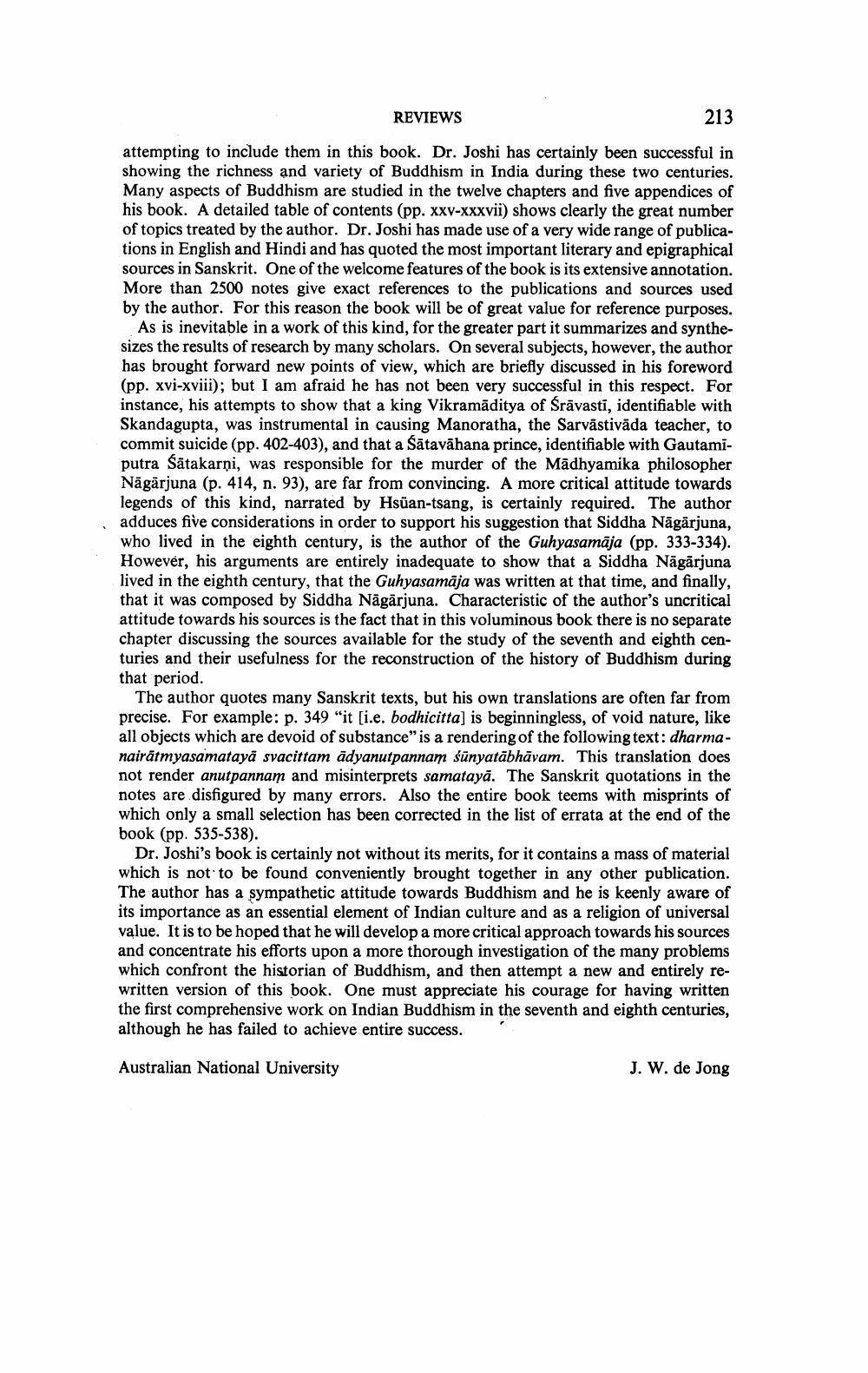Book Title: Reviews Of Different Books Author(s): Publisher: View full book textPage 7
________________ REVIEWS 213 attempting to include them in this book. Dr. Joshi has certainly been successful in showing the richness and variety of Buddhism in India during these two centuries. Many aspects of Buddhism are studied in the twelve chapters and five appendices of his book. A detailed table of contents (pp. XXV-xxxvii) shows clearly the great number of topics treated by the author. Dr. Joshi has made use of a very wide range of publications in English and Hindi and has quoted the most important literary and epigraphical sources in Sanskrit. One of the welcome features of the book is its extensive annotation. More than 2500 notes give exact references to the publications and sources used by the author. For this reason the book will be of great value for reference purposes. As is inevitable in a work of this kind, for the greater part it summarizes and synthesizes the results of research by many scholars. On several subjects, however, the author has brought forward new points of view, which are briefly discussed in his foreword (pp. xvi-xviii); but I am afraid he has not been very successful in this respect. For instance, his attempts to show that a king Vikramaditya of Sravasti, identifiable with Skandagupta, was instrumental in causing Manoratha, the Sarvastivada teacher, to commit suicide (pp. 402-403), and that a Satavahana prince, identifiable with Gautamiputra Satakarni, was responsible for the murder of the Madhyamika philosopher Nagarjuna (p. 414, n. 93), are far from convincing. A more critical attitude towards legends of this kind, narrated by Hsuan-tsang, is certainly required. The author adduces five considerations in order to support his suggestion that Siddha Nagarjuna, who lived in the eighth century, is the author of the Guhyasamaja (pp. 333-334). However, his arguments are entirely inadequate to show that a Siddha Nagarjuna lived in the eighth century, that the Guhyasamaja was written at that time, and finally, that it was composed by Siddha Nagarjuna. Characteristic of the author's uncritical attitude towards his sources is the fact that in this voluminous book there is no separate chapter discussing the sources available for the study of the seventh and eighth centuries and their usefulness for the reconstruction of the history of Buddhism during that period. The author quotes many Sanskrit texts, but his own translations are often far from precise. For example: p. 349 "it [i.e. bodhicitta] is beginningless, of void nature, like all objects which are devoid of substance" is a rendering of the following text: dharmanairatmyasamataya svacittam adyanutpannam sunyatabhavam. This translation does not render anutpannam and misinterprets samataya. The Sanskrit quotations in the notes are disfigured by many errors. Also the entire book teems with misprints of which only a small selection has been corrected in the list of errata at the end of the book (pp. 535-538). Dr. Joshi's book is certainly not without its merits, for it contains a mass of material which is not to be found conveniently brought together in any other publication. The author has a sympathetic attitude towards Buddhism and he is keenly aware of its importance as an essential element of Indian culture and as a religion of universal value. It is to be hoped that he will develop a more critical approach towards his sources and concentrate his efforts upon a more thorough investigation of the many problems which confront the historian of Buddhism, and then attempt a new and entirely rewritten version of this book. One must appreciate his courage for having written the first comprehensive work on Indian Buddhism in the seventh and eighth centuries, although he has failed to achieve entire success. Australian National University J. W. de JongPage Navigation
1 ... 5 6 7 8 9 10 11 12 13 14 15 16 17 18 19 20 21
